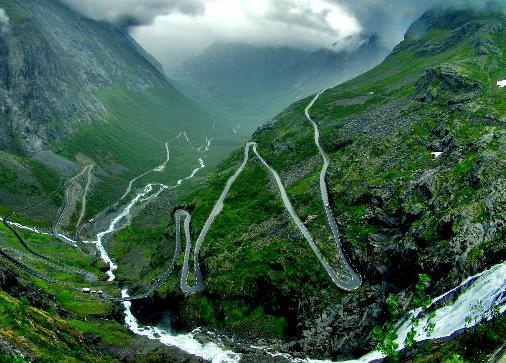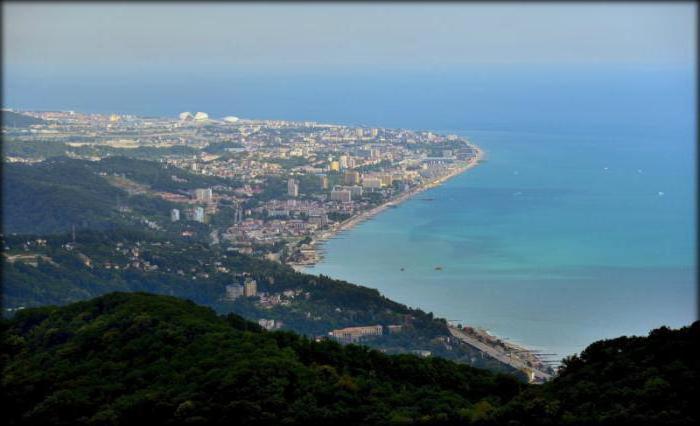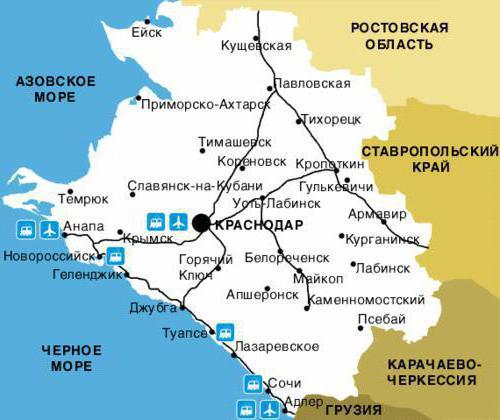In Latin, “serpent” is a snake. She crawls, wriggling her body with all kinds of squiggles. The serpentine is the same way - the road, snaking wriggling to the left, then to the right, rises in the mountains or goes around them. Such tracks are designed where it is impossible to create even sections or where straight lines produce too steep descents and ascents. For the construction of serpentines, there are special standards (GOSTs) that determine the minimum allowable radius of bends, maximum steepness and many other indicators, compliance with which allows to protect drivers and passengers. And still, driving along such roads always looks like a test. Mountain serpentine in Sochi or in another way the A147 highway is a vivid confirmation of this. Here, accidents happen almost every week, sometimes very serious, and traffic jams happen every day. In our article, we tried to provide useful information on how to overcome this section of the path with minimal loss of time and health.

Serpentine Length
To answer the question of how many kilometers you have to circle in the mountains, you need to decide where the serpentine begins on the road to Sochi. To the village of Dzhubga from the side of Gelendzhik it is practically absent, only ordinary turns are found on the highway. You can also safely go to Novomikhailovsky. Only after this village for about several km there are a couple of sharp turns, something like a little training for those who are coming here for the first time. Further to the village of Agoy, the track is again quite calm. There are also several sharp turns on the Agoy – Tuapse road section, but not yet a serpentine. It starts, one might say, right outside the city, as soon as you pass the neighborhood with the cute name Romashka, pass by turning left to Shahumyan Street and turning right, onto a road that goes around the local villages and also looks a bit like a little serpentine. It will have to intersect again almost immediately after Kroyansky. If we take into account that the distance between the borders of Sochi and Tuapse is 119 km and subtract from it even sections at the entrances, then the length of the serpentine in Sochi will be about 110 km. By the way, the direct distance between these cities is only 77 km.

Road condition
Previously, the Sochi serpentine caused many complaints from drivers, but fortunately, the Olympics helped. The road was restored to its opening, and now, according to the drivers, it has a pretty good condition. There are no holes on it, but in some places there are small patches. Serpentine in Sochi has two lanes and dividing markings throughout. The width of the stripes is such that it is possible to part easily on even inserts even two large wagons. Plus, almost everywhere there are curbs where you can park in case of need. There are about a thousand turns on the highway, but there are few steep 180 ° turns. In such areas with loaded multi-ton, it can be difficult to part, as part of the trailers they often jump out into the oncoming lane. In general, serpentine stretches along a cliff or steep cliffs not everywhere. At different sections of the route, it passes through the forest or past settlements and is overcome quite calmly.
Specifications
Let's try to explain what the Sochi serpentine is. The road is laid along the mountains along the Black Sea coast and is very picturesque almost throughout its length. Its coating is asphalt concrete, about 8 meters wide, although it is much narrower on bridges. On some bridges, the two lanes converge into one, as reported by roadside signs. Also, lane traffic exists in areas where road works are carried out. Throughout the route there are 6 quite dangerous descents and about a dozen too sharp turns. The speed on the road is controlled by indicators. There are sections where it is allowed to drive 70 km / h, and there are also those where you can “accelerate” to just 15 km / h. All road signs are set not for "tick", but on the basis of technical conditions, so they must be observed. The difference in altitude on the track is up to 200 meters, which causes health problems for many. Service along the highway is well established, there is where to refuel and have a bite.

Possible difficulties
According to the drivers, the most dangerous serpentine in Sochi is near settlements. There, children and adult citizens often jump out onto the road (not always adequate). Also in the areas near the villages there are cows and goats that are in no hurry to leave and create traffic jams.
Another danger, especially in the summer heat - overheating of the brakes, if you go so that they often use.
Another kind of trouble that can wait on the road is a meeting with a traffic police officer, and there are plenty of them on the highway. They check not only the speed of the car, but also the intersection of the wheels of the dividing markings.
For passengers who have problems with the vestibular apparatus, a trip along the serpentine road becomes a real torture, as they cradle such people at multiple turns.
When is the best time to go?
Serpentine in Sochi is in maximum demand in the summer. Pedestrians, traffic lights, accidents (and they also occur, and there can be several at a time on the highway), repairs - all this creates traffic jams. Here they come in two types - large and very large. Therefore, experience shows that it is better to go to Sochi somewhere from 12 a.m. to 5-6 a.m. According to the testimony of drivers, at night from Tuapse to Sochi you can get home in 3 hours, and some get even faster. In the afternoon, the same path sometimes stretches for 8 hours. The fault is traffic jams. In summer, additional inconvenience is heat, and in winter, snow and ice crust on the road. In this case, winter tires on wheels are more than relevant.
Pros and cons of night trips
Experienced drivers advise those who for the first time overcome the serpentine in Sochi to do this in the daytime. After all, such people do not have knowledge about the features of the track and all its "pitfalls". During the day, road signs, markings, and the environment surrounding the road are better visible. And for those who are not afraid of experiments, the night track will certainly enjoy more.
Benefits:
- not so hot;
- there are no children on the roads and very few adult pedestrians;
- there are no large trucks that also create congestion on the road;
- there are practically no passenger buses that in some way interfere with the driving of cars;
- there are no traffic cops, so you can not be distracted by the control of the dividing line;
- From afar you can see the headlights of a car going towards it.
The road to Lazarevsky
From Tuapse, the road to Sochi leads through the wonderful village of Lazarevskoye. It’s only 48 km to go there (according to other sources 51 km), of which a complex serpentine will take about half the route. A few km to Lazarevsky and the same after it, the road, in principle, is straight, there is enough space for overtaking, but there are signs of a decrease in speed, since the village. Locals advise visitors not to go any further, because in Lazarevsky vacation is much cheaper than in Sochi, and the services are the same.
Experienced drivers advise, reaching this village, be sure to make a stop in it to rest before continuing on the serpentine.
You can drive from Tuapse to Lazarevsky in an hour or a little more if there are no traffic jams. Otherwise, the journey takes hours.
The road from Lazarevsky to Sochi
More or less sharp turns after Lazarevsky begin in the area of the Soloniki station and stretch to the village of Golovinka. The length of the route is almost 21 km. Here, the road to Sochi also has bends, slides, and small even inserts. In Golovinka you can eat, relax a bit. After this settlement, a more or less normal path lies to the village of Loo, or rather, to w. d. station "Mountain air". From here to Dagomys one more section of the serpentine with rather sharp turns has to be overcome, but it stretches for less than 8 km, and in a straight distance 5.6 km. The train overcomes them in just 8 minutes. In principle, Dagomys is already Sochi, more precisely, one of its housing estates. Having reached this place, we can assume that the serpentine is subdued. But the center of Sochi is still 11 km away, which will also meet several turns.
Tips "experienced"
Driving a serpentine in Sochi will pass without problems, if you follow the simplest rules:
- do not ignore traffic signs;
- Do not go overtaking, if there is no absolute certainty that it will be completed before the start of the turn (you need to take into account that the overtaken car can also suddenly accelerate);
- if a row of cars is lined up behind, let them pass by the side of the road (this can earn the respect of drivers and avoid a lot of trouble);
- Do not start moving along the serpentine, if you feel tired;
- Do not arrange competitions with local "dzhigits" that are worn on the roads, not particularly observing the rules.
How to get around serpentine in Sochi
According to many drivers, this road is no worse than others, and if you follow the rules, driving along it brings a lot of pleasure. It is impossible to go round it. True, the locals say that there is a primer along the coast, but they themselves still ride along the serpentine. You can only go round the section from Dzhubgi to Tuapse (or vice versa). This is mainly done in order to avoid the huge number of traffic jams dragging on the bride. Following from Novorossiysk, it is possible, before reaching Dzhubga, turn onto M4, get to Goryachiy Klyuch, turn off to Khadyzhensk.
Next, keep the path not to Absheron, but towards Kurinskaya, cross the
Shaumyansky pass and continue to Tuapse. On Absheron it is necessary to turn off those who are traveling not to Sochi, but to Adygea or Maykop. According to drivers, the roundabout is three times longer, but getting through it is faster, since traffic jams there are a rarity. The road is very pleasant, asphalted, with beautiful landscapes, shade from trees, almost no sharp turns and almost no holes. There are even rare gas stations and cafes here. The only inconvenience is a 7 km stretch covered with gravel and therefore very dry in dry weather and dirty in rain. It is located on the pass itself. They do not pave it, fearing the movement of soil into the mud.
Serpentine in Sochi: reviews
Those who are not afraid of heights and do not experience health problems on bends, love the mountain road A 147.
Noted advantages:
- beautiful landscapes;
- good road surface;
- developed infrastructure;
- perfectly visible markings along the entire route.
Marked Cons:
- frequent traffic jams;
- drivers who do not comply with the rules;
- pedestrians jumping out onto the road.